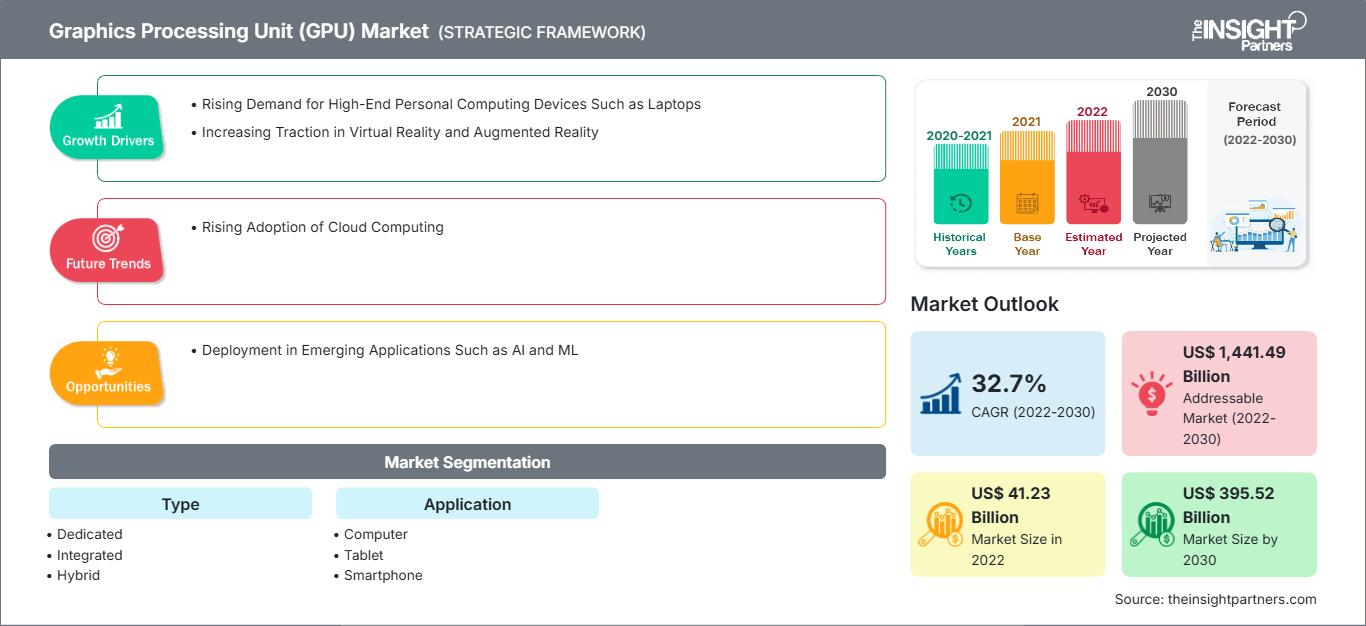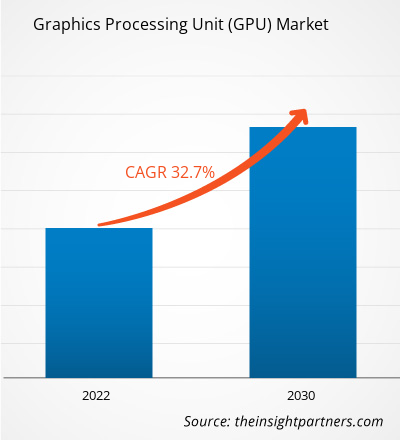Der Markt für Grafikprozessoren (GPUs) soll von 41,23 Milliarden US-Dollar im Jahr 2022 auf 395,52 Milliarden US-Dollar im Jahr 2030 wachsen; von 2022 bis 2030 wird mit einer durchschnittlichen jährlichen Wachstumsrate von 32,70 % gerechnet. Die wichtigsten Trends auf dem Markt sind voraussichtlich.
Marktanalyse für Grafikprozessoren (GPUs)
Die weltweit hohe Verbreitung von Computerprodukten wie Laptops oder Personal Computern (PCs) und die steigenden Investitionen in die Spielebranche sind die Hauptfaktoren für das Wachstum des Marktes für Grafikprozessoren (GPUs). Die steigende Nachfrage nach fortschrittlichen Grafik- und Computeranwendungen und die Entwicklung von Technologien wie KI sowie die Tendenz zur Echtzeitanalyse erweitern den Anwendungsbereich der Grafikprozessortechnologie (GPUs). Faktoren wie die kontinuierliche Weiterentwicklung grafikbasierter Spiele, die Entwicklung von Virtual Reality (VR) und Augmented Reality (AR), der Trend zu künstlicher Intelligenz (KI) und die zunehmende Verbreitung von Computern und Gaming-Laptops dürften das Marktwachstum für Grafikprozessoren (GPUs) vorantreiben. Darüber hinaus wird erwartet, dass der florierende Markt für tragbare Wearables und Elektronik sowie die zunehmende Popularität des Internets der Dinge (IoT) das Wachstum des Marktes für Grafikprozessoren (GPUs) im Prognosezeitraum vorantreiben werden.
Branchenübersicht für Grafikprozessoren (GPUs)
GPU steht für Graphics Processing Unit und ist eine elektronische Schaltung zur Verarbeitung von Computergrafiken und Bildern. Anders ausgedrückt: GPUs helfen bei der Bilderzeugung auf Mobiltelefonen oder Computern, insbesondere bei rechenintensiven Anwendungen wie Videospielen. Die CPU übernimmt in gewisser Weise einen Großteil der Rechenleistung von Computern, Mobiltelefonen und Spielekonsolen, konzentriert sich jedoch auf die visuelle Darstellung und Grafik.
GPUs sind ein außergewöhnliches Beispiel für Technologie, die sowohl professionellen als auch Unterhaltungszwecken dient. Die wachsende Gaming-Branche und die zunehmende Popularität von Kryptowährungs-Mining und KI-Technologie kurbeln das Wachstum des GPU-Marktes an. Realistische und ansprechende Grafiken sind eines der wichtigsten Verkaufsargumente für anspruchsvolle Videospiele, sodass die Nachfrage nach erstklassigen Grafikkarten voraussichtlich konstant hoch sein wird. Auch VR, das hohe Anforderungen an die Grafikleistung stellt, erfreut sich wachsender Beliebtheit. GPUs bieten zudem wesentliche Vorteile aufgrund ihrer hochgradig parallelen Natur. KI wird zu einem wesentlichen Bestandteil zahlreicher Geschäftslösungen, und GPUs sind bei der Verarbeitung von KI-Operationen weitaus effektiver als CPUs.
Passen Sie diesen Bericht Ihren Anforderungen an
Sie erhalten kostenlos Anpassungen an jedem Bericht, einschließlich Teilen dieses Berichts oder einer Analyse auf Länderebene, eines Excel-Datenpakets sowie tolle Angebote und Rabatte für Start-ups und Universitäten.
Markt für Grafikprozessoren (GPU): Strategische Einblicke

-
Holen Sie sich die wichtigsten Markttrends aus diesem Bericht.Dieses KOSTENLOSE Beispiel umfasst Datenanalysen, die von Markttrends bis hin zu Schätzungen und Prognosen reichen.
Markttreiber und Chancen für Grafikprozessoren (GPUs)
Die wachsende Popularität des Internets der Dinge (IoT) fördert das Marktwachstum
GPUs sind ein integrales System zur Förderung des IoT. Sie ermöglichen eine funktionsreiche, nahtlose IoT-Schnittstelle, die branchenübergreifend ein flächendeckendes Benutzererlebnis ermöglicht. Zu den Anwendungen von GPUs im IoT gehören 3D-Grafiken für die zusammengesetzte Verarbeitung von Benutzeroberflächen und dynamische 3D-Benutzeroberflächen. Entwicklungen bei hybriden und integrierten GPUs können die idealen Anforderungen von IoT-Systemen erfüllen, die akzeptable Formfaktoren mit sehr geringem Stromverbrauch aufweisen und für batteriebetriebene Geräte geeignet sind. Darüber hinaus sind GPUs die Hauptanforderung tragbarer Elektronikprodukte, auf die das IoT abzielt, wie Digitalkameras und Camcorder, Smartphones, tragbare Elektronik, Laptops und Tablets sowie Haushaltselektronik. Daher wird erwartet, dass die wachsende Popularität des IoT eine Chance für das Wachstum des GPU-Marktes schafft.
Virtual Reality und Augmented Reality gewinnen an Bedeutung
Virtual Reality (VR) und Augmented Reality (AR) sind zwei neue Technologien, die in einer Vielzahl von Branchen, darunter Gaming, Gesundheitswesen, Unterhaltung und Bildung, immer beliebter werden. VR- und AR-Geräte benötigen leistungsstarke Grafikprozessoren (GPUs), um immersive und realistische Erlebnisse darzustellen. GPUs sind verantwortlich für die Erstellung der komplexen 3D-Grafiken und Echtzeiteffekte, die für VR- und AR-Erlebnisse erforderlich sind. VR- und AR-Spiele erfreuen sich zunehmender Beliebtheit, und viele der neuesten VR- und AR-Headsets benötigen leistungsstarke GPUs, um ausgeführt zu werden. Dies liegt daran, dass VR- und AR-Spiele das Rendern komplexer 3D-Welten und -Charaktere in Echtzeit erfordern.
In der Unterhaltungsindustrie werden VR und AR verwendet, um immersive Erlebnisse für Filme, Fernsehsendungen und Musikvideos zu schaffen. Dies ist ein weiterer Bereich, in dem leistungsstarke GPUs benötigt werden, um die hochwertigen Grafiken zu rendern, die für diese Erlebnisse benötigt werden. Im Bildungssektor können Schüler mithilfe von VR-Geräten verschiedene historische Epochen erleben oder den menschlichen Körper detailliert erforschen. AR kann verwendet werden, um digitale Informationen in die reale Welt einzubetten, beispielsweise um Schülern Beschriftungen für Pflanzen und Tiere bereitzustellen. Der zunehmende Einsatz von VR und AR im Bildungsbereich treibt somit die Nachfrage nach GPUs an.
Segmentierungsanalyse des Marktberichts für Grafikprozessoren (GPU)
Die wichtigsten Segmente, die zur Ableitung der Marktanalyse für Grafikprozessoren (GPU) beigetragen haben, sind Produkt und Anwendung.
- Der Markt ist nach Typ in dediziert, integriert und hybrid segmentiert. Das integrierte Segment hatte 2023 den größten Marktanteil.
- Der Markt ist nach Anwendung in Tablets, Smartphones, Computer, Spielkonsolen, Fernseher und andere segmentiert. Das Smartphone-Segment hatte 2023 den größten Marktanteil.
Marktanteilsanalyse für Grafikprozessoren (GPU) nach geografischer Lage
Nach Regionen ist der Markt in Nordamerika, Europa, Asien-Pazifik, Naher Osten und Afrika sowie Süd- und Mittelamerika unterteilt.
Der europäische GPU-Markt verzeichnet derzeit aufgrund der steigenden Nachfrage aus den Bereichen Gaming, Rechenzentren und Automobil ein leichtes Wachstum. In Europa nimmt die Nutzung von Rechenzentren rasant zu, da viele Unternehmen Cloud-Computing und Technologien für künstliche Intelligenz (KI)/Maschinelles Lernen (ML) einsetzen. Auch die Zahl der Rechenzentren in der Region wächst. So war beispielsweise Start Campus eine der wichtigsten Ankündigungen des Jahres 2021. Südlich der portugiesischen Hauptstadt Lissabon soll ein 4,2 Milliarden US-Dollar teurer Rechenzentrumscampus mit 495 MW entstehen, ein Markt, dessen Wert derzeit auf weniger als 1 Milliarde US-Dollar geschätzt wird. Ebenso kündigte der italienische Hyperscale-Rechenzentrumsbetreiber Aruba an, dass er beabsichtigt, im Jahr 2023 die Türen des größten Rechenzentrumskomplexes Roms zu eröffnen. Somit treibt die steigende Zahl von Rechenzentren in Europa das Wachstum des GPU-Marktes voran.
Markt für Grafikprozessoren (GPU)
Die Analysten von The Insight Partners haben die regionalen Trends und Faktoren, die den Markt für Grafikprozessoren (GPU) im Prognosezeitraum beeinflussen, ausführlich erläutert. In diesem Abschnitt werden auch die Marktsegmente und die geografische Lage von Grafikprozessoren (GPU) in Nordamerika, Europa, im asiatisch-pazifischen Raum, im Nahen Osten und Afrika sowie in Süd- und Mittelamerika erläutert.Umfang des Marktberichts zu Grafikprozessoren (GPU)
| Berichtsattribut | Einzelheiten |
|---|---|
| Marktgröße in 2022 | US$ 41.23 Billion |
| Marktgröße nach 2030 | US$ 395.52 Billion |
| Globale CAGR (2022 - 2030) | 32.7% |
| Historische Daten | 2020-2021 |
| Prognosezeitraum | 2022-2030 |
| Abgedeckte Segmente |
By Typ
|
| Abgedeckte Regionen und Länder |
Nordamerika
|
| Marktführer und wichtige Unternehmensprofile |
|
Dichte der Marktteilnehmer für Grafikprozessoren (GPU): Verständnis ihrer Auswirkungen auf die Geschäftsdynamik
Der Markt für Grafikprozessoren (GPUs) wächst rasant. Dies wird durch die steigende Endverbrauchernachfrage aufgrund veränderter Verbraucherpräferenzen, technologischer Fortschritte und eines stärkeren Bewusstseins für die Produktvorteile vorangetrieben. Mit der steigenden Nachfrage erweitern Unternehmen ihr Angebot, entwickeln Innovationen, um den Bedürfnissen der Verbraucher gerecht zu werden, und nutzen neue Trends, was das Marktwachstum weiter ankurbelt.

- Holen Sie sich die Markt für Grafikprozessoren (GPU) Übersicht der wichtigsten Akteure
Marktnachrichten und aktuelle Entwicklungen für Grafikprozessoren (GPU)
Der Markt für Hochgeschwindigkeitssteckverbinder wird durch die Erhebung qualitativer und quantitativer Daten nach Primär- und Sekundärforschung bewertet, die wichtige Unternehmensveröffentlichungen, Verbandsdaten und Datenbanken umfasst. Einige der Entwicklungen auf dem Markt für Grafikprozessoren (GPU) sind unten aufgeführt:
- NVIDIA Corporation kündigte GeForce RTX SUPER-Desktop-GPUs für übertaktete generative KI-Leistung, neue KI-Laptops aller Top-Hersteller und neue NVIDIA RTX an – beschleunigte KI-Software und -Tools für Entwickler und Verbraucher. (Quelle: NVIDIA Corporation, Pressemitteilung, Januar 2024)
Bericht zum Markt für Grafikprozessoren (GPU): Abdeckung und Ergebnisse
Die Marktprognose für Grafikprozessoren (GPU) wird auf Grundlage verschiedener sekundärer und primärer Forschungsergebnisse geschätzt, wie z. B. wichtiger Unternehmensveröffentlichungen, Verbandsdaten und Datenbanken. Der Marktbericht „Marktgröße und Prognose für Grafikprozessoren (GPU) (2021–2031)“ bietet eine detaillierte Analyse des Marktes und deckt die folgenden Bereiche ab:
- Marktgröße und Prognose für Grafikprozessoren (GPU) auf globaler, regionaler und Länderebene für alle wichtigen Marktsegmente, die im Rahmen abgedeckt sind
- Markttrends für Grafikprozessoren (GPU) sowie Marktdynamik wie Treiber, Einschränkungen und wichtige Chancen
- Detaillierte PEST/Porters Five Forces- und SWOT-Analyse
- Marktanalyse für Grafikprozessoren (GPU) mit wichtigen Markttrends, globalen und regionalen Rahmenbedingungen, wichtigen Akteuren, Vorschriften und aktuellen Marktentwicklungen
- Branchenlandschafts- und Wettbewerbsanalyse mit Marktkonzentration, Heatmap-Analyse, prominenten Akteuren und aktuellen Entwicklungen auf dem Markt für Grafikprozessoren (GPU)
- Detaillierte Unternehmensprofile.
- Historische Analyse (2 Jahre), Basisjahr, Prognose (7 Jahre) mit CAGR
- PEST- und SWOT-Analyse
- Marktgröße Wert/Volumen – Global, Regional, Land
- Branchen- und Wettbewerbslandschaft
- Excel-Datensatz
Aktuelle Berichte
Erfahrungsberichte
Grund zum Kauf
- Fundierte Entscheidungsfindung
- Marktdynamik verstehen
- Wettbewerbsanalyse
- Kundeneinblicke
- Marktprognosen
- Risikominimierung
- Strategische Planung
- Investitionsbegründung
- Identifizierung neuer Märkte
- Verbesserung von Marketingstrategien
- Steigerung der Betriebseffizienz
- Anpassung an regulatorische Trends






















 Kostenlose Probe anfordern für - Markt für Grafikprozessoren (GPU)
Kostenlose Probe anfordern für - Markt für Grafikprozessoren (GPU)